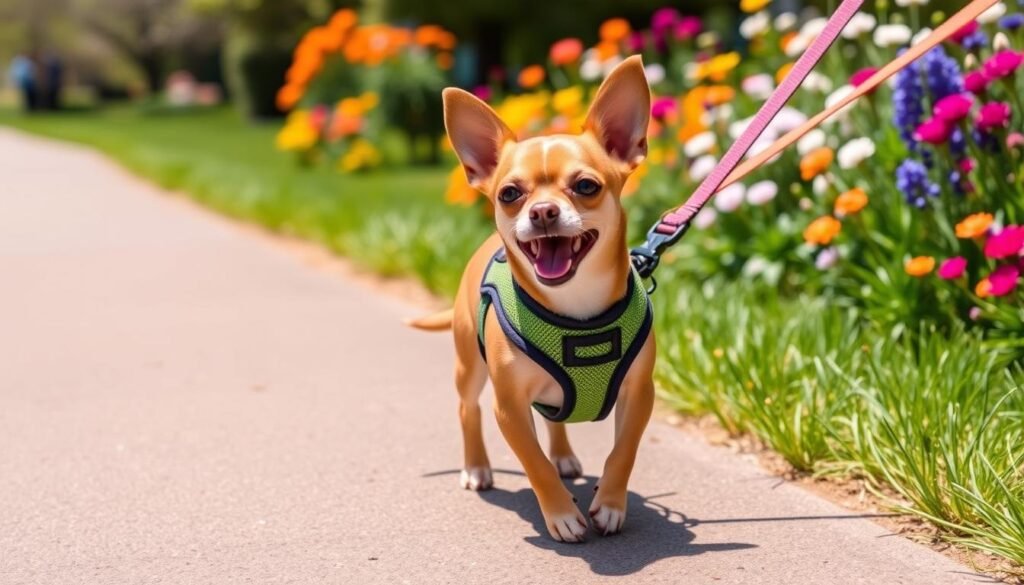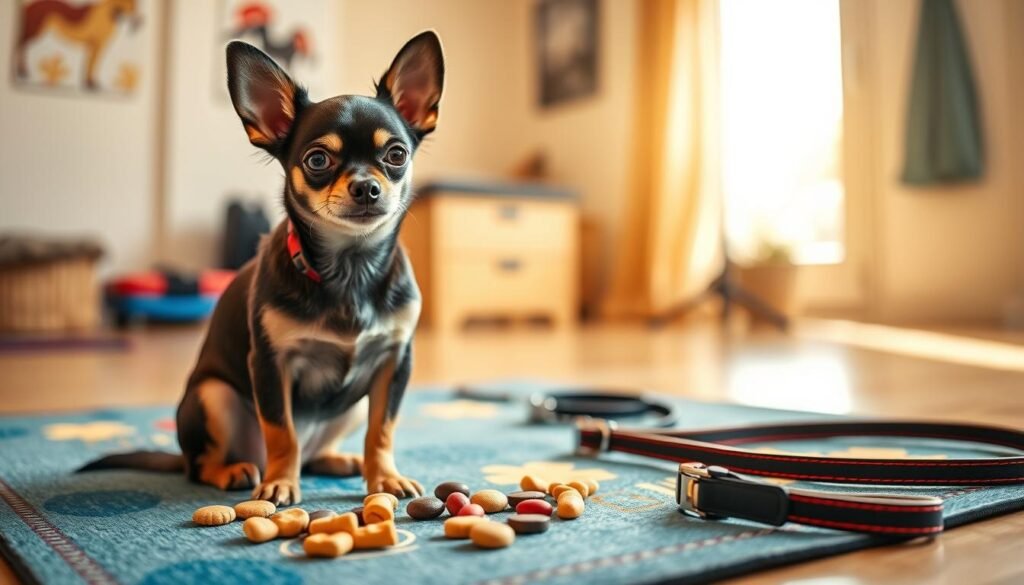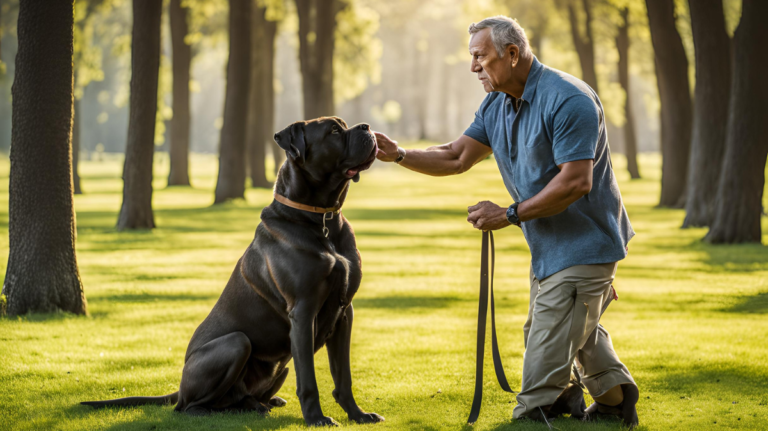Welcoming a Chihuahua into your home is truly a joy. These little dogs have big hearts and offer lots of love. But, they also need proper training. Training your Chihuahua is not just about commands. It’s also about creating a strong bond. This can be through potty training or teaching them to obey. The secret is knowing their unique personality and using positive ways to train them.

Key Takeaways
- Chihuahuas may need more frequent bathroom breaks compared to larger breeds due to their small size1.
- Starting training early, ideally at 8 weeks old, can help establish good habits2.
- Daily exercise, like walking twice a day, is crucial for both physical health and training1.
- Positive reinforcement, including treats that make up only 10% of daily caloric intake, can be highly effective for Chihuahuas12.
- Consistency, such as maintaining a routine for potty breaks and obedience sessions, is key in reinforcing good behavior2.

Understanding the Chihuahua Breed
Chihuahuas are unique and charming, known for their mix of boldness and love. They make great pets when you know how to train and live with them. It’s important to understand their characteristics, behaviors, and how they feel.
Unique Characteristics of Chihuahuas
Chihuahuas are tiny, weighing between 2 to 6 pounds and standing 5 to 8 inches tall. They have short or long coats in many colors like black, white, and chocolate3. They’re smart, thanks to their big brains, and learn quickly4. Plus, they live a long time, usually 14 to 16 years3.
Common Behaviors to Expect
Without proper socialization, Chihuahuas might act boldly or even aggressively towards strangers and other dogs. With early training, you can shape their behavior nicely4. They need daily fun and games to keep their minds and bodies active. Try hiding treats around the house for them to find5.
Size and Temperament Considerations
The way Chihuahuas act depends a lot on their training and socialization. Despite their small size, they have a confident nature. Consistent, positive training helps them learn fast3. Starting training early ensures they grow up to be friendly pets. Be careful when they’re around bigger dogs to avoid any harm3.
The Importance of Early Socialization
Getting your Chihuahua used to the world early is key to a happy pet. The best time for them to learn is between 3 and 14 weeks old6. This is when they’re open to learning what’s safe and good.
Benefits of Socializing Your Chihuahua
Starting socialization early can make your Chihuahua calmer and less scared of new things7. They’re likely to be friendlier and easier to manage at the vet or grooming appointments6. Socialized Chihuahuas adjust better to new places, making them happier overall7.
Techniques for Effective Socialization
To socialize your puppy well, slowly introduce them to new places, sounds, and smells8. Here are a few methods:
- Controlled playdates: Set up playtimes with friendly dogs for good interactions.
- Puppy classes: Join puppy programs like the AKC S.T.A.R. Puppy program, which offers training and social activities8.
- Public outings: Take your Chihuahua to various public areas to meet different people and see different sights7.
Introduce new things slowly and use positive rewards to encourage them6. Be careful not to overload your puppy with too much all at once.
Basic Commands Every Chihuahua Should Learn
Training your Chihuahua is key for their good behavior and safety. They are smart and faithful, so Chihuahuas learn commands quickly and have fun training9. Start training them early to avoid problems like aggression and too much barking10.
Essential Commands for Training
Every Chihuahua needs to know “sit,” “stay,” “come,” and “heel”11. These commands keep them safe9. You can start training as soon as they’re 8 weeks old. Keep the sessions short, 5 to 10 minutes, to keep them effective11.
Teaching Your Chihuahua to Sit
Teaching your Chihuahua to “sit” is rewarding. Use capturing or luring methods11. Hold a treat near their nose and raise it over their head. When they look up, their bottom will sit. Say “sit,” give them the treat, and praise them11. With regular practice, they’ll quickly learn this command.
Teaching Your Chihuahua to Stay
The “stay” command is tougher but very important. Begin with your Chihuahua sitting. Then, hold out your palm and say “stay.”11 Slowly move away from them, keep looking into their eyes11, and use treats to encourage them. They should stay seated until you say they can move10.
Adding gestures, eye contact, and changing your voice tone makes training better. It makes each session more fun for both you and your pet9.
Sticking with it and using positive reinforcement are crucial for good training. Practice regularly and offer lots of praise to raise a well-behaved Chihuahua.
Leash Training Tips for Chihuahuas
Leash training is key for your Chihuahua’s safety and comfort on walks. Using good methods and the right gear can help a lot.

Choosing the Right Leash and Harness
Chihuahuas can get hurt with regular collars and leashes, so a harness is safer. It stops pressure on their fragile necks and lets you control walks better12. Choose a harness that’s padded and can be adjusted for a snug fit. Aim for a light leash that’s simple to handle.
Steps for Successful Leash Training
Start leash training your Chihuahua inside to get them used to a harness. This way, there are no outdoor distractions. Slowly take them outdoors, keeping the first few walks short and happy. Use treats like hot dogs, cheese, or dried meat for rewards, teaching your Chihuahua to stay by your side12. The Push, Drop, Stick method also works well13.
Walking Etiquette for Chihuahuas
Teaching your Chihuahua to walk nicely by your side makes walks enjoyable for both of you. Use consistent commands and treats to avoid pulling or stopping. This also stops your Chihuahua from tangling around your legs12. With patience and consistency, walks will be fun.
| Leash Training Elements | Key Points |
|---|---|
| Choosing Equipment | Go for a harness to avoid neck injuries and improve control12. |
| Training Methods | Stick to rewarding positively with treats12. |
| Walking Etiquette | Use steady commands and rewards to keep your dog close12. |
| Gradual Introduction | Start training inside, then go outside, beginning with short walks12. |
| Training Adjustments | Apply the Push, Drop, Stick strategy for better results13. |
House Training Your Chihuahua
Living peacefully with your Chihuahua means good house training. This includes potty training and using a crate. These methods help create a well-behaved and joyful pet.
Potty Training Techniques
Potty training your Chihuahua needs patience and sticking to a plan. Take them outside to the same spot many times a day14. Look out for signs like whining, circling, and sniffing. These tell you when they need to go14. Young puppies might need to go out up to 14 times daily15.
Giving treats or praise when they go outside helps them learn14. If they have accidents, don’t get mad. This can scare them14. Watching them closely outside helps make sure they finish14. Sometimes, they’ll need a few trips before they go14.
Crate Training Best Practices
Crate training works because dogs don’t like to mess where they sleep. A cozy crate teaches them to wait before going14. The crate should be a happy place, not where they pee or poop15.
Make sure the crate feels like part of the family area. This avoids them feeling left out. The crate is not just for potty training. It’s a safe spot for them to relax and have their space.
Positive Reinforcement Techniques
Positive reinforcement for dogs is all about rewarding their good behavior. It’s better than punishing them for bad behavior.
It’s key to understand how this technique works, especially with small dogs like Chihuahuas. Rewards need to be given right after the good behavior. That way, your dog connects the reward with what they just did16. This approach is based on operant conditioning. It teaches dogs the positive outcomes of their actions17.
Understanding Positive Reinforcement
To do positive reinforcement, you add something your dog loves, like treats or praise. It makes them want to repeat the good behavior17. It’s important for everyone in the family to use the same commands. This avoids confusing your dog. Having everyone on the same page makes training easier16.
Types of Rewards to Use
You can use different rewards in positive reinforcement. Food treats work really well because dogs usually love food16. You can also use kind words, toys, or extra playtime. Start by rewarding the behavior every time. It helps your dog make the connection. Later, you can reward sometimes to keep the behavior going16. Mixing up treats and adding praise can help too.
How to Implement Reinforcement Effectively
For positive reinforcement to work, you need a good plan. Always reward good behavior right away. Once your dog gets better, change up how often you give rewards. This keeps things interesting16. Mix treats and praises to make training fun. This method doesn’t just teach your dog. It also makes your bond stronger17.
Lots of professional trainers suggest positive reinforcement. This includes groups like the Association of Professional Dog Trainers16.
Dealing with Behavioral Issues
Understanding your Chihuahua’s behavior is key to a happy life together. These dogs have big personalities that sometimes lead to challenges.
Common Problems Faced by Chihuahua Owners
Owners often deal with their Chihuahuas barking too much, showing aggression, and being overly possessive. These behaviors often come from anxiety, territorial instincts, or not enough socializing. For example, Chihuahuas might act aggressively towards new people, especially when on their owner’s lap18. They also tend to get very attached to one person and might need time to get used to others18.
Strategies for Addressing Aggression
Handling aggression in dogs means figuring out what triggers them and gently changing their behavior. A method called desensitization, where you slowly get your Chihuahua used to whatever sets off their aggression in a safe way, works well19. It’s vital to keep trying and set clear rules19. Training with treats and praise works wonders because Chihuahuas love them18. Always use the same commands to help your dog learn better, as repeating helps them understand20.
Tips for Reducing Barking Habits
If your Chihuahua barks a lot, it can be annoying20. Teaching them to be “quiet” and cutting down on what makes them bark helps a lot. Having a daily routine with enough play, bonding, and exercise keeps them behaved19. A busy dog is a quiet dog20. Using rewards strengthens your bond and makes them listen more20.
Using these tips, you can fix unwanted behaviors in your Chihuahua. This makes for a happier and better-behaved pet.

The Role of Consistency in Training
Sticking to a schedule is key when training your Chihuahua. You need to keep a steady routine, use the same commands, and have set consequences. This method helps your dog know what to expect, creating a secure environment for them.
Why Consistency Matters
Being consistent in training can help your dog behave better by up to 80%21. If everyone in the home uses the same rules and commands, it means your dog gets less mixed up. This can cut down on bad behavior by 60%21. Also, dogs are 70% more likely to act right in different places if they’ve had consistent training21. Using the same training methods helps your Chihuahua understand and learn better.
How to Create a Training Schedule
Setting up a training schedule is important for your dog’s learning. Pick certain times each day for training, like before breakfast or after a walk. This gets your Chihuahua used to a routine they can count on. Make sure you mix up the commands and activities so your dog stays interested.

| Time | Activity | Details |
|---|---|---|
| 7:00 AM | Morning Walk | 20-minute walk to stimulate your Chihuahua’s mind and body |
| 8:00 AM | Basic Commands | Training session focusing on sit, stay, and come commands |
| 12:00 PM | Playtime | Interactive games to reinforce obedience and social skills |
| 4:00 PM | Behavior Training | Addressing specific behavior issues like barking or aggression |
| 7:00 PM | Evening Walk | Another 20-minute walk to help your dog unwind before bedtime |
A solid training schedule helps with your dog’s behavior. It’s all about keeping a regular routine and giving clear instructions. Training this way also cuts down the time it takes to teach your Chihuahua by 40%21. A steady schedule makes for consistent training and lays a great foundation.
Integrating Training into Daily Life
Making training a part of your Chihuahua’s everyday life can be fun and easy. Simple commands can be included during play, meals, and regular activities. This offers constant chances to learn and maintain good behavior all day.
Incorporating Training into Playtime
Mixing training with your dog’s playtime works well. For example, make your Chihuahua sit or stay before throwing a ball. It turns learning into a fun activity for both of you. Studies show that adding games into training makes it more effective and enjoyable22.
The “Focus on Me” game is good during playtime. It rewards your Chihuahua for looking at you despite distractions. This can improve focus and make training more enjoyable23. These activities turn obedience training into a happy time for your pet.
Everyday Opportunities for Training
Meal times offer great chances for training. Teaching your Chihuahua to sit calmly before eating helps build discipline. Conduct training where your dog feels comfortable. This helps them learn better without stress22.
Walks are also perfect for training. Letting your Chihuahua sniff around during walks boosts focus and lowers stress. Adding games like pace changes teaches your dog to follow your speed. This improves focus and involvement in walks23.
- Using the “Focus on Me” game to reward attention
- Implementing the Red Light/Green Light game to improve impulse control
- Engaging in Parkour activities to boost confidence and coordination
Training for Special Situations
Training your Chihuahua for special moments can make them less anxious and stop bad behaviors. Focus on vet visit training and training dogs for travel. Getting your Chihuahua ready for these events means a happier time for both of you.
Preparing for Vet Visits
Vet visits can scare Chihuahuas because they’re wary of new places and faces. Start by touching your pet like a vet would. This means checking their paws, ears, and mouth. Chihuahuas can have tooth and gum problems, so these checks help them get used to being handled. They also let you spot dental issues early24.
Reward them with treats and love to link good feelings with these actions. This uses their love for food to promote calmness25.
Training for Traveling with Your Chihuahua
Traveling with a Chihuahua can be fun if they’re used to it. Begin with short car rides, slowly going further. Make sure their travel area is safe and has their favorite things25. Chihuahuas have a lot of energy and can get nervous or excited in new places. Getting them used to traveling helps calm them25.
Use toys or games to keep them busy and stop bad behavior when traveling for a long time. Chihuahuas are quick to notice things and can get anxious or shake when too excited. By recognizing these signs and adapting your training, you can meet their specific needs24. Regular short rides and constant rewards for calmness will make them like traveling, making longer trips easier for your pet.
| Health Considerations | Training Tips |
|---|---|
| Heart Disease, Dental Issues | Regular veterinary-like handling, positive reinforcement24 |
| Nervousness, Energy Levels | Gradual travel acclimation, mental stimulation during travel25 |

Choosing the Right Training Resources
Looking for training materials for your Chihuahua can be overwhelming. Choose resources that focus on small breeds and tackle their common behaviors. This approach will make your training more effective.
Recommended Books and Guides
Beginning your training with reliable Chihuahua books is a smart move. These books cover everything from simple commands to complex skills. They’re great for new owners, giving a step-by-step training path. It’s important to pick books that promote positive reinforcement. This way, you and your Chihuahua will enjoy learning together26.
Here are a few good books:
- “Chihuahuas for Dummies” – A complete guide to training and understanding Chihuahuas.
- “The Chihuahua Handbook” – Offers special training advice for the breed’s unique issues.
Online Resources for Chihuahua Training
Nowadays, online training resources are gaining popularity. Websites with video tutorials offer clear, step-by-step advice for all levels of experience. These are great for people who learn visually and want to see how things are done27. Videos showing hand signals are especially helpful, as some Chihuahuas respond well to them27.
Good online sites also have forums. Here, you can share stories and advice with other Chihuahua owners. Online courses allow you to learn at your own pace. They’re flexible, letting you fit training into your day-to-day life. This ensures your Chihuahua gets regular training.
Mixing Chihuahua training books with online resources is a balanced strategy. Using different types of learning, you’ll be ready for both the challenges and fun of training your Chihuahua.
| Resource Type | Benefits |
|---|---|
| Chihuahua Training Books | Structured approach, in-depth breed-specific insights, flexible reading pace |
| Online Dog Training | Visual demonstrations, community support, flexible and interactive learning |
Seeking Professional Help
Training your Chihuahua at home can be rewarding. But, sometimes, you might need professional help. Knowing when to seek a trainer and what to expect can hugely impact your dog’s growth and behavior.
When to Consult a Trainer
Is your Chihuahua showing serious behavioral problems? Things like intense aggression, non-stop barking, or major anxiety are signs. It’s probably time to see a professional dog trainer. They offer special training programs to meet specific needs. Whether it’s for behavior change or advanced obedience. Places like Dog Training Elite get great reviews for handling a variety of behaviors28.
What to Expect from Professional Training Sessions
Professional training for your Chihuahua will likely focus on obedience, changing behaviors, and making friends. Trainers often use positive rewards to boost good behavior. For example, a training center in Chicago has all the right tools. They use positive rewards and offer classes, private sessions, and puppy meet-ups for all ages29.
Expert trainers, like the ones at Dog Training Elite, pay close attention to each Chihuahua. They make sure your dog gets top-notch care and advice28.

FAQ
What are the unique characteristics of Chihuahuas?
What behaviors should I expect from my Chihuahua?
Why is socializing my Chihuahua important?
What are some techniques for effective Chihuahua socialization?
What basic commands should my Chihuahua learn?
How do I teach my Chihuahua to sit?
How do I choose the right leash and harness for my Chihuahua?
What steps can ensure successful leash training?
How can I establish a successful potty training routine for my Chihuahua?
What are the best practices for crate training my Chihuahua?
How does positive reinforcement help in Chihuahua training?
How can I address aggressive behaviors in my Chihuahua?
Why is consistency important in training my Chihuahua?
How can I incorporate training into my Chihuahua’s daily life?
How can I prepare my Chihuahua for vet visits?
What resources are recommended for Chihuahua training?
When should I consult a professional trainer for my Chihuahua?
What should I expect from professional training sessions?
Source Links
- https://www.dogster.com/lifestyle/how-to-train-a-chihuahua
- https://lensandleash.com/essential-chihuahua-training-tips/
- http://furrybabiesportage.com/understanding-the-chihuahua-breed-furry-babies-portage/
- https://www.chichisandme.com/train-chihuahua-part-introduction/
- https://citizenshipper.com/blog/essential-chihuahua-training-tips-master-obedience-behavior/
- https://longwoodvetcenter.com/pet-socialization-raising-a-well-adjusted-dog/
- https://breedingchihuahuadogs.com/the-importance-of-early-socialization-for-your-chihuahua/
- https://www.akc.org/expert-advice/training/puppy-socialization/
- https://www.hotbot.com/answers/how-to-train-a-chihuahua
- https://www.petassure.com/new-newsletters/helpful-tips-training-your-chihuahua/
- https://www.akc.org/expert-advice/training/teach-your-puppy-these-5-basic-commands/
- https://wagwalking.com/training/train-a-chihuahua-to-walk-on-leash
- https://zigzag.dog/en-us/blog/puppy-training/breed-specific/how-to-train-a-chihuahua-puppy/
- https://www.dogster.com/dog-training/how-to-potty-train-a-chihuahua
- https://puppybee.com/how-to-potty-train-a-chihuahua-puppy/
- https://www.humanesociety.org/resources/positive-reinforcement-training
- https://www.akc.org/expert-advice/training/operant-conditioning-positive-reinforcement-dog-training/
- https://healthyhoundz.com/2020/05/chihuahua-training-tips-fighting-small-dog-syndrome/
- https://vcahospitals.com/know-your-pet/puppy-behavior-and-training—dealing-with-undesirable-behavior
- https://www.akc.org/expert-advice/training/how-to-curb-unwanted-dog-behaviors/
- https://www.hortondogs.co.uk/tips-and-advice/training-communication-and-consistency-the-key-to-a-well-behaved-dog/
- https://dogadventuresnw.com/the-power-of-relationship-based-dog-training/
- https://www.akc.org/expert-advice/training/dog-training-games-for-walks/
- https://www.trainpetdog.com/breed/Chihuahua/
- https://royvon.co.uk/top-tips-on-training-chihuahua-dogs/
- https://www.akc.org/expert-advice/training/finding-choosing-a-dog-trainer/
- https://www.chichisandme.com/how-to-train-your-chihuahua-part-iv/
- https://dogtrainingelite.com/chicago/training/service-dog
- https://tuckerpups.com/our-services/dog-training/dog-training-chicago.php




